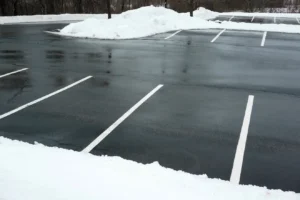How to deliver Outstanding Winter Gritting using Tech and AI
OUTCO recently featured in the September 2024 edition of Facilities Management Journal, where our Chief Technology Officer, Brendon Petsch, shed light on the intricate world of keeping businesses operational through the winter.
Here is his fascinating and insightful look into the high tech world of winter gritting:
We often bemoan the way that bad winter weather can bring our country grinding to a halt, but the past decade has seen snow and ice clearance grow ever more sophisticated. However, with so much occurring under the cover of darkness – or even more mysteriously in the digital ether between smartphones and server rooms – it can be astonishing how much technology is keeping businesses running in the toughest conditions.
To shine a light on this process, let’s take a ride with an OUTCO customer. Meet John, senior operations manager for an online retailer. It’s 7am on a frozen winter morning and he’s carefully driving in to start work at his company’s fulfilment centre in the Midlands. Having already passed two accidents, he’s wary of the icy road surfaces and already thinking ahead to the logistical challenges this might throw up during the day.
As he arrives at work, he passes several trucks already crossing the huge concourse, apparently undeterred by the conditions. While their onward journey may present challenges, the site itself is working as usual.
Winter Gritting contract set up
To understand how, we need to go back several months when John was on holiday in his shorts and flip flops and a contract to grit the fulfilment centre was being agreed. When a new site is brought on board – which often occurs in the spring or summer – a survey-based assessment takes place which details the nature of a site and the specific risks likely to occur. This, in addition to the customer’s risk appetite, sets the activation triggers for a given site. Some clients may accept a standard road surface temperature of 0ºC to activate a winter gritting visit, whereas more risk averse customers may impose even more stringent rules on gritting criteria. These rules are all established and locked in at the survey and contract stages.
Automated Service Triggers
OUTCO receives and processes a daily raw data weather file with tens of thousands of data points over a 24-hour period, containing numerous weather variables – including the all-important road surface temperatures. With so much information, it’s simply unusable to a human operator and has to be automatically imported into a patented weather app within our bespoke CRM system, Nimbus, and analysed using our proprietary algorithms.
The CRM system cross references the weather data points to the variables and rules for John’s site and creates a yes or no decision for winter gritting or snow clearance. Once John’s activation threshold has been reached, a winter gritting job is automatically created and the OUTCO team is despatched to site.
On the coldest of nights, this automated process can generate up to 10,000 gritting and snow clearance jobs for various clients across the country for delivery that night in a matter of minutes.
As well as generating the jobs for the evening ahead, the weather app and CRM system send out pre-service notifications to clients like John to let them know to expect a visit and what service will be delivered. This includes a snapshot of the weather data and other variables that informed the decision to trigger their service.
Balancing Automation with Human Intuition
Thus far this has been an automated, data-driven process, but today’s winter operations do still benefit from human expertise and experience.
The operations teams can review all the jobs for the evenings and have a window of a couple of hours before lunchtime in which they can change around teams or jobs as needed. This is supported by telematics software that helps to manage the teams of operators, who themselves are supported by a bespoke smartphone app – Pulse – that works on their Apple or Android devices. At around 1pm, every operator’s phone will ping to show the jobs for the night that each operator has been allocated.
Technology alone won’t get the best results: although you could optimise routes and resources to the nth degree using routing software, we allow our operators to decide how best to handle the route to allow them to respond in the moment to conditions on the ground. Clearly it makes no sense to service a site if there’s rain passing through that location that will wash away the grit, so this flexibility lets the teams judge when during the evening to schedule the visit for the safest outcomes.
By using local operators to service the same sites, operators have intricate knowledge of the site and the clients specific instructions and requirements, ensuring we get it right and provide a quality service every time. for example, when you’re working overnight you need to know that your operator knows how to access a site (i.e. has any keys they need) and has the detailed knowledge of whereabouts to work.
This is where it’s important to stress that technology and human experience aren’t in tension but reinforce each other. for example, should there be any doubt as to where exactly to grit, the boundaries of a site will have been accurately geofenced in advance so things won’t get confused even when it’s dark and snowy. Upon arrival at a site, OUTCO’s automated validation system kicks in, ensuring that the operator is in the correct location before allowing the gritting process to take place. GPS locators pinpoint the operator to the specific location where gritting is required, removing any guesswork.
Managing and Mitigating Risk
The app will also give operators access to all of the risk assessment information, the service plan and any special instructions for that site. Operatives are also kept safer on the job as the real time connection between the Pulse app and the Nimbus CRM system will allow us to know where people are working and that they are safe and on the right site.
On the flip side of the coin, Nimbus can also pass that feed in real-time to clients via a client app or portal. Had John worried about the conditions the night before, he could have logged in to see that the gritting truck was enroute.
This feed of data shows exactly where grit has been laid on site and also lets everyone validate that the service has been delivered – an essential breadcrumb trail of evidence for reporting and compliance purposes.
The mobile apps also allows operators to report any new risks or issues. Let’s say an air conditioner is leaking and leaving a trail of water that might create an increased slipping hazard – that can be captured in real-time so the client can be made aware.
This series of process and integrated technologies helps with the immense amount of heavy lifting required to service thousands of sites in poor conditions under time pressure. Without this, the added burdens of human effort, communication, time and cost would be significant.
And the result? John parks up, zips up his jacket against the cold as he strides across the expanse of tarmac. Without a thought for the night’s activity, he watches as the lorries pull up to the loading docks and it’s business as usual without any winter related interruptions.
For more information on how OUTCO can bring an innovative approach to your winter gritting, contact us on 0800 0432 911








